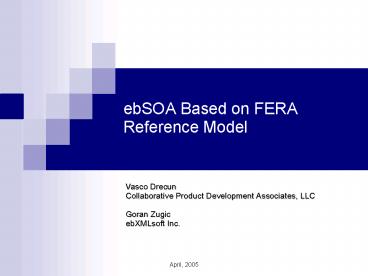ebSOA Based on FERA Reference Model - PowerPoint PPT Presentation
1 / 12
Title:
ebSOA Based on FERA Reference Model
Description:
Sign-on, authentication, plug-in services (meetings, calendars, chat, ... Plug-in Services. Security ... Plug-in Services. Web services based on ebSOA Plug-in ... – PowerPoint PPT presentation
Number of Views:20
Avg rating:3.0/5.0
Title: ebSOA Based on FERA Reference Model
1
ebSOA Based on FERA Reference Model
Vasco DrecunCollaborative Product Development
Associates, LLCGoran ZugicebXMLsoft Inc.
2
FERA reconciles BPM with SOA
3
Recognizing FERA configuration
- Four process characteristics determine what FERA
configuration is required - Human interaction determines the need for portal
and collaborative services capabilities - Sign-on, authentication, plug-in services
(meetings, calendars, chat, visualization,
reporting, etc.) - Process administration determines the need for
federation server and gateways - Security, protocols, content exchange formats,
meta-data mapping, B2B process standards
(RosettaNet, CPFR, ) - Process flow determines the need for event
management - Alerts, Escalation, Messaging, Queries, Flow
controller - Business logic reconciliation determines the need
for agent framework - Synchronous vs. asynchronous reconciliation
4
Mapping to FERA components
- Reference model steps
- Step1 Define content and context elements
(static view Federation Information Model (FIM)
and Collaborative Process Information Model
(CPIM)) - Step 2 Define choreography (dynamic view)
Collaborative Process Flow Information Model
(CPFIM) and Agent Interface Information Model
(AIIM) - Step 3 Determine FERA configuration. Four
configurations are formally specified and they
support all possible collaboration cases
(patterns) examined so far. - Step 4 Document FERA capabilities and specific
features required to support the choreography
(requirements) - Step 5 Select applicable standards for the
specified capabilities and features - Step 6 Produce a final document with all
architectural requirements and components to
support the pattern - Step 7 Deploy to ebSOA
5
FERA Functional Architecture
SOA Federation
Federation Server
Gateway
Gateway
Federated User
Federated User
Agent Framework
CP Flow
Plug-in Services
Plug-in Services
Collaborative Services
6
ebSOA Information Model
- Federation Information Model (FIM) Content and
Context - FIM is an informational bridge between the public
and private world. - Definition of federate profiles, business process
specifications, collaboration protocols and
agreements, security policies, etc. Information
that supports public processes and documents of
any type for both public and private processes. - Agent Interface Information Model defines types
of agents, invocation rules and status control. - Collaborative Process Information Model (CPIM)
- Supports complete CP context including all
possible flows, participants and shared context
elements like metrics, rules and joint events - The main CPIM entities are CP Flows, Roles,
Rules, Metrics and Clusters of Events - Collaborative Process Flow Information Model
(CPFIM) - Supports definition of the possible flows of
activities, decisions and events within the CP - The main CPFIM entities are Activities, I/O-s,
Events, Triggers, Decisions, Sequences,
References, etc.
7
ebSOA Collaboration Semantics
- ebSOA collaboration semantics in connection with
ebSOA information model provides full dynamic
collaboration support. - ebSOA collaboration semantics formally defines
all necessary interfaces with methods/functions
required for the collaboration data (ebSOA
information model) manipulations and interactions
between SOA Federation architectural components.
SOA Federation is a central block of the ebSOA
architecture with the following components which
interfaces and methods/functions are already
defined as a part of the ebSOA architectural
specification - Gateway
- Portal
- Plug-in Services
- Security
- SOA Federation (Federation Server, Agent
Framework, CP Flow Controller and Collaborative
Services)
8
ebSOA Collaboration Data and Semantics(Business
Process Management)
SOA Federation
ebSOA Collaboration Semantics
ebSOA Collaboration Semantics
9
ebSOA Specifications
- ebSOA Specifications include both static (SOA
Federation Information Model) and dynamic view of
the ebSOA architecture. The dynamic view support
includes formalized ebSOA collaboration semantics
of the SOA Federation internal collaboration and
its interface for the external collaborations
(federated systems) via Federation Server and
Gateway. - The key components of the ebSOA Specifications
include - ebSOA Information Model that fully supports
informational aspects of both external and
internal collaborations - Collaboration semantics and interfaces for
- Gateway
- Portal
- Plug-in Services
- Security
- SOA Federation (Federation Server, Agent
Framework, CP Flow Controller and Collaborative
Services)
10
ebSOA
SOA Federation
G
Federation Server
A
T
E
W
A
Y
I
N
T
E
R
F
A
C
E
CP Flow Controller
Collaborative Services
11
ebSOA Standard-Based Components Mapping
- Gateway
- - Public processes
- ebXML BPSS for public process collaborations
- ebXML CPP/CPA
- - Business documents creation and validation
- OASIS CAM
- - Communication
- ebXML Messaging, SOAP with WS-Security, SMTP,
JMS, - etc.
- - Interface
- ebSOA Gateway Interface specification.
- - Registry
- Gateway Registry based on standard (ebXML
Registry, UDDI) or - proprietary implementation.
- Portal
- Web server portal based on ebSOA Portal
Interface specifications - Plug-in Services
- Web services based on ebSOA Plug-in Services
Interface specification - Agent Framework
12
ebSOA Standard-Based Components Mapping (cont.)
- Federation Server
- - Federation Manager
- ebSOA Federation Manager Specification
- - Agent Interface Manager
- ebSOA Agent Interface Manager Specification
- - Federation Registry
- ebXML Registry Specifications (RIM and RS)
- - Security Provider
- ebSOA Security Provider Specification, XACML,
SAML, etc. - Process Flow Registry
- Based on ebSOA Process Flow Registry
Specification - Flow Controller, Event Manager, Activity Manager
and Decision Manager - Based on ebSOA Flow Controller, Event Manager,
Activity Manager and - Decision Manager Specifications.
- Collaborative Services
- Third-party tools for data analysis, reporting,
collaboration pattern analysis, data quality,
etc.































